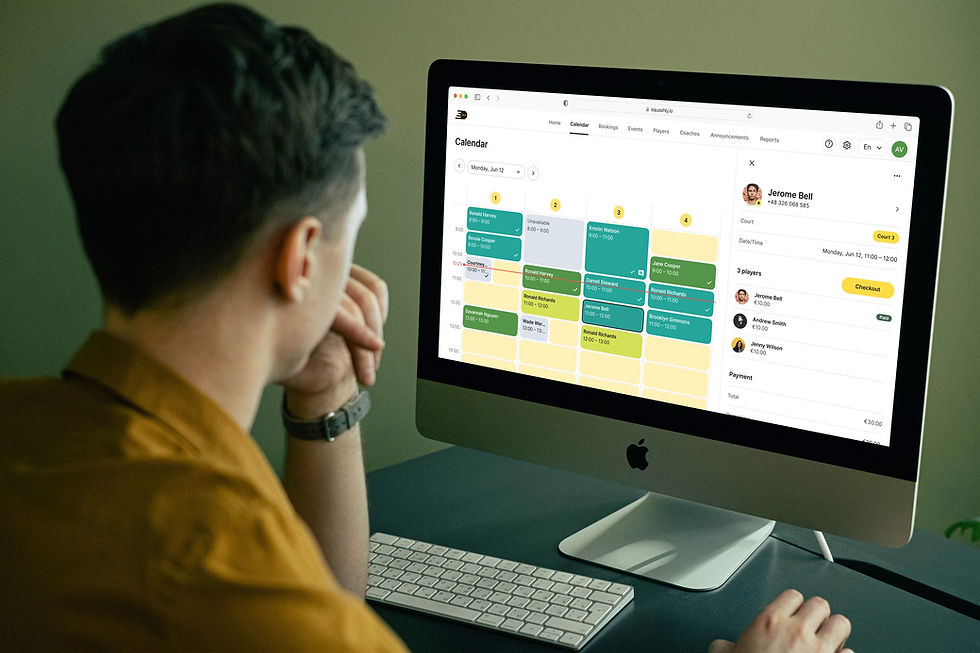AI for Better Matches: How Artificial Intelligence is Enhancing Racquet Sports Facilities
- Markus Gaebel

- Jun 24
- 3 min read

Racquet sports like squash, padel, and pickleball are undergoing a quiet revolution driven by artificial intelligence (AI). Smart cameras analyze matches, automated systems assess playing levels in seconds – all these tools aim to help facility operators provide more balanced games, foster social interaction, and build long-term engagement among players. This article explores current and emerging AI technologies relevant to racquet sports facilities and shows how they can enhance the overall experience.
AI-Powered Match Analysis: Cameras and Sensors in Action
AI-enabled camera systems are becoming increasingly common. These smart setups track rallies, record key stats, and deliver real-time analytics. While squash already has some early solutions, padel and tennis are also seeing rapid uptake of smart court technology. Sensors – in rackets or wearable devices – can complement video analysis by capturing swing power, footwork, and more.
For facility operators, this technology delivers a double benefit. On one hand, it supports training with objective performance feedback. On the other, it adds value by turning regular matches into "smart games" with personal statistics reports – a motivational tool for recreational players.
Well-Matched Opponents: Balanced Games Are Key
Sport is most fun when players are evenly matched. Yet newcomers often struggle to find suitable opponents. One-sided games – whether too easy or too hard – are frustrating. That’s why quickly and accurately assessing a new player’s skill level is crucial.
AI can play a central role here. Newcomers could be evaluated after just a few minutes of play via a smart camera. The system then assigns them to a skill category, eliminating guesswork. This enables facilities to offer immediate access to fair and fun matches – increasing the likelihood that visitors return.
Rating Systems as the Digital Backbone

Once player skills are measured, a rating system can become the connective tissue of the facility. Each player gets a level that adjusts automatically after each match. The benefits are far-reaching:
Smarter match-finding: Members can use booking tools to find opponents with similar ratings, reducing hesitation to play with new people.
Fairer tournaments and leagues: Ratings enable objective seeding and grouping.
Visible progress: Like fitness apps during the pandemic, rating improvements provide motivation and a sense of achievement.
Ideally, these ratings should be portable between clubs and platforms, allowing players to take their score wherever they play.
Fostering Social Connections and Retention
Racquet sports are inherently social – you need partners to play. With AI-based ratings and matchmaking, even new members can quickly connect with the community. They don’t need to know anyone beforehand; the system ensures fair pairings.
This technology addresses a deeper issue: social isolation. Many people seek not just exercise but connection. A facility that helps them find balanced matches naturally becomes a welcoming social hub – a key factor in member retention.
Staying Competitive in Racquet Facilities with AI Smart Technology
The digital shift has also created competition: platforms like Playtomic connect millions of players and offer AI matchmaking. For traditional clubs and smaller facilities, this poses a challenge – but also an opportunity.

By integrating smart technology into their own systems, local facilities can match or even exceed the user experience offered by the big platforms. Smart rating and matchmaking tools can attract younger demographics, enable structured leagues, and boost booking frequency.
Conclusion
Artificial intelligence is redefining grassroots and recreational racquet sports. From onboarding new players to organizing tournaments, AI systems center the experience around fair play, social interaction, and personal progress. Facilities that embrace this trend will see stronger member loyalty, better community building, and a new generation of players drawn in by the ease and excitement of smart play.




Comments